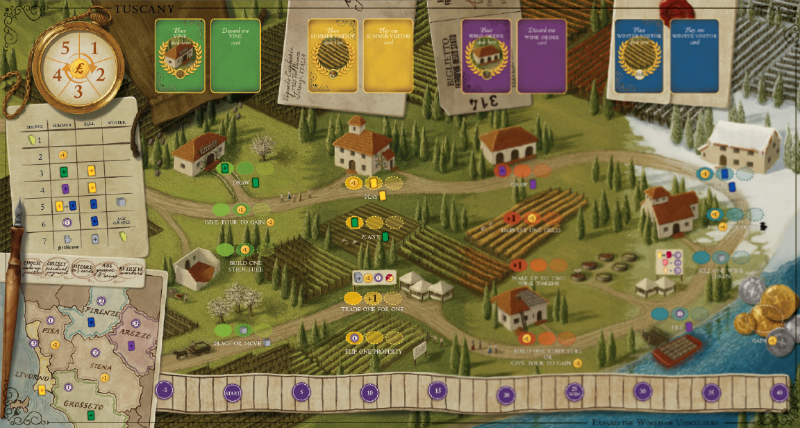Making cheap wine can be easy, but making a good wine takes time, patience, and a good palate. Luckily, we’re here to talk about the good kind. It turns out that your vineyard has been so profitable and successful that it’s time to expand. So, welcome to Tuscany, the multi-tiered expansion for the wine-making worker placement game, Viticulture.
Tuscany, however, is not your normal expansion project. The manner it is added to Viticulture is an essential part of what makes this project as intriguing as it is varied.
Tuscany has adopted a form of legacy-style gameplay, made famous by Risk: Legacy designer Rob Daviau. In legacy games, players have a vested interest in the outcome of the game beyond winning. When certain conditions or playthroughs are completed, these games ‘unlock’ certain attributes, forcing the players to make a permanent choice about the state of the game. (As in, for as long as you own the game type permanent.) Legacy games instill a real sense of progression and purpose from one session to the next, and when completed, it exhibits a set of characteristics that ultimately tells a story unto itself.
Tuscany doesn’t go so far as to add ‘forever and ever’ permanence to Viticulture, but it comes pretty close by adopting the legacy-style method of unveiling new expansions. Yes, expansions. Plural. Tuscany is, in fact, not one expansion, but several. (By our calculations, at the time of this preview, Tuscany should now consist of ten.)
Expansions work on a tiered rollout plan: after a determined upon number playthroughs of Viticulture (the recommendation is to do a few games per expansion), the winner of that game decides which Tier I expansion to add to the game next. Once chosen, all subsequent games will use that expansion as if the game came that way. After a few more playthroughs, another is added, and so on. Tier I expansions tend to make relatively small changes to the game, but these changes do add up. And this is what they offer:
Tier I Expansions
Mamas & Papas
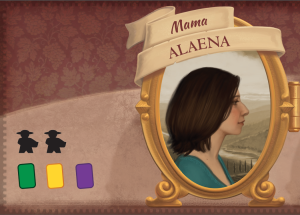
Mama gives two workers, a Vine, a Summer Worker, and a Wine Order. (Prototype Shown)
In Mamas & Papas, your vineyard has finally garnered the attention of your parents. So they’re planning a visit. Since everyone’s parents are a little different, so too are their impacts on the visit.
Mamas & Papas replaces the normal starting resources with random ones. Each player receives a Mama card and a Papa card to start the game, which provide a variety of initial cards, money and/or structures. While this expansion may seem rather innocuous, it’s potentially the most impactful of the Tier I expansions. It affords players the ability to pursue different strategies right from the start of the game, and it’s more difficult to predict what your opponents are doing.
Yes, who would have thought that Mom and Dad showing up at your work could disrupt normal routines?
Property
If you’played Viticulture before, you’ve probably experienced a time or seven when you don’t use all three fields. Unless mass production of wine tokens is your primary focus, you’re going to have a field or two fallow. Were that an actual field, it’d be seen as a waste of space and revenue.
Property changes that. This expansion allows you to make use of those fields, by selling them. Instead of having three fields with a vine cap of six, players receive fields that hold values of five, six, and seven. The tradeoff is that those fields can be sold off for extra cash. When taking the appropriate action, you may sell a field off for its cap value. That field is effectively no longer yours and can’t be used to plant in anymore, but it can be a quick way to make extra cash. And, if you ever need to, you can always buy it back at cost. Yes, at cost.
(Hey, this is about wine-making, not real estate.)
Patronage
Your vineyard has been doing quite well over these last few years, and it’s attracted a lot of visitors in that time to see your operation. Apparently though, in the latest edition of Grape and Stem monthly, your place has caught the attention of a wealthy patron who could raise your prestige even higher. That is, if you’re willing to play their game.
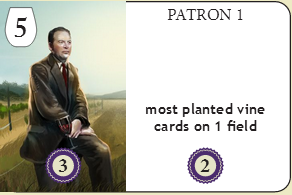
Prototype Shown
Patronage adds the concept of secret information to the game of Viticulture. At the beginning of the game, each player is given a secret Patron card. The left side of the card is identical for each player. To activate the Patron, you act as if it were a Wine Order card. The Patron always wants a five-value wine, and it can be of any kind. You don’t get any residuals from it, and the Patron always awards 3VP for it. However, doing so also activates the right side of the Patron card, which is kept secret from the other players, adding a layer of intrigue.
At the end of the game, it affords you an extra 2VP – if the condition on the card is met. This could be something like “Have the Least Structures Among Players”, or “Have the Most Vines Planted”. This lets players work on a hidden agenda on top of their other duties, and apparently one of those is to cater to the whims of eccentric millionaires.
Advanced Visitors
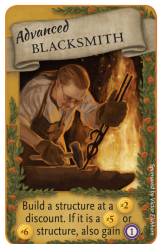
This Tuscany expansion doesn’t have an immediate impact on the beginning of the game. Rather, the use of Advanced Visitors pays off in its later stages. These visitors are more complex than the kind that you’re used to, and their sophistication and avant-garde approaches can be quite helpful.
Advanced Visitors are new Summer and Winter Visitor cards that are shuffled in to the base decks. Each Advanced Visitor card provides you with an Either / Or option. One of the options is more beneficial when you’re first starting out, while the other is better suited as the game progresses along. These cards are quite useful at diluting the effect of occasionally drawing Visitor cards past a point in the game when you can benefit from them, and the influx of them helps mitigate such ‘dead draws’. They’re like normal Visitors. Just better.
Tier II Expansions
Once all four Tier I expansions are added, Tuscany unlocks the four Tier II expansions to be chosen from. Parts of each of the Tier II expansions require Tier I expansions to be present, hence the need for them to be cumulatively added before proceeding. What do these Tier II expansions add? A lot. A whole lot of lot. These include:
New Visitors
Yes, if the Advanced Visitors – the more learned version of many base Visitors – wasn’t enough, your vineyard’s fame has continued to grow and attract more attention. This (unsurprisingly) consists of an even greater variety of people venturing to see how you do that wine thing that you do so well.
New Visitors adds a host of even more powerful and nuanced cards to the Summer and Winter Visitor decks. These cards run the gambit of benefits from being taking actions without needing a worker, placing a worker on an action space for the next year, to cards that provide you a bonus (but offer your opponents options as well), to cards that provide conditional VP if you meet the criteria. For example, the Grower says, “Plant 1 vine. Then, if you have planted at least 6 total vine cards, gain 2 VP”.
There is a reason the New Visitor cards are a Tier II expansion, even though it doesn’t initially make sense. Part of this is because of how they interact with other expansions, and part of it is because of the potency some of these cards offer. You’ll want to be used to playing Viticulture normally before diving into the strategic options these cards provide, as they can certainly shake things up.
Special Workers
One thematic thing worker placement games often get knocked for is that all workers, identical to the next, behave in a drone-like fashion. You never feel connected to them in any way, even in Viticulture (with the exception of the grey temporary worker whom we still call the Tuscan Zoro). Stonemaier Games is astutely aware of that thematic lapse, and they experimented with diversifying the worker pool some in their second game, Euphoria. While successful there, they’ve taken the idea one step further in Tuscany by giving us unique meeple workers.
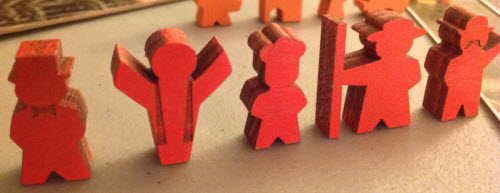
Prototype Shown
There are a number of Special Workers available in Tuscany (the total will be dependent on the campaign’s Stretch Goals). At the beginning of the game, two Special Worker cards are chosen at random, and only those are available that game. When you purchase or gain a new worker, you may pay an additional coin to select a Special Worker instead. These workers do count towards your six-worker limit, and each player is limited to one Special Worker of each kind. However, in addition to being fantastic custom meeples, those workers provide special abilities outlined on their cards. For instance, using the Farmer meeple allows you to always gain that action’s bonus even if you’re not on a bonus space.
These workers add yet another degree of customization as to how you wish to implement your game’s strategy, and their unique skillsets should not go unnoticed. Some may be more suitable than others depending on the number of players and your own ambitions, but they are certainly something to consider when filling out all those new hiring forms.
The Expanded Board
You’ve continually been climbing the ladder of success with your vineyard operation, and you’re quite happy with how well it’s going. Revenue is up, production is soaring, and you continue to gain recognition throughout the region. You’ve consulted with your crew and decided it’s time to take your company to the next level.
And boy do you.
The Expanded Board of Tuscany doesn’t just add another section to the game board – it replaces it. This expansion fundamentally changes the actions available in the game, when they are available to you, and adds a few new ones in as well. This is what the new board looks like:
While the Expanded Board still largely functions the same way you’re used to, players have to take into account some major changes. First, Viticulture now plays out over all four seasons instead of just two, and when you pass at the end of Winter, you essentially do your end of year stuff (aging, claiming workers, selecting next year’s placement, etc.) before everyone else. You also now need a minimum of 25 VP to win.
Second, this expansion changes how the wake-up chart behaves. Turn order is no longer rotated, but it is something that is claimed by taking the 7-spot instead. (It is also the only way to get the first wake-up spot.) All other spots are still selected the same way, but each one provides one or more rewards. When you pass out of a season, you move your rooster across the row and claim the reward.
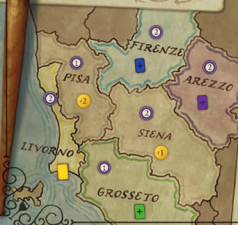
The new influence track.
Third, it adds the idea of regional influence. As your reach extends out into the Tuscan countryside, it’s essential to factor that into your success. This is done through influence cubes. Each player begins the game with six of them, and whenever you see a grey block on the Expanded Board, that gives the player the action to add or move one of their influence blocks to the region map in the bottom left of the board.
Each region contains a VP amount and and either a card or money symbol. Placing your cube on that region gets you that card or coin amount. Alternatively, you may move a cube to another region. At the end of the game, the player in each region with the majority of cubes in it receives its VP amount.
The Expanded Board vastly changes the look and scope of the game of Viticulture, but at its heart it’s the same wine-peddling, worker-driven game you know. It may be a whole new map to explore, with all new strategies to try out, but it’s totally worth the effort.
Structures
Building an ever-expanding business requires a lot of things. More capital, more revenue, more workers, and more infrastructure. That last one doesn’t usually get a lot of attention in most places, but it does here.
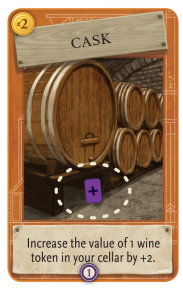
Prototype Shown
Structures opens up a whole host of new building opportunities for players to purchase throughout the course of the game. If you’ever thought there just wasn’t enough building options in the game, Structures will be the expansion for you. Each building can be purchased using the normal building actions, and they’re built on empty fields (or the expansion board it comes with). When built they provide both a static ability for use during the game and a VP amount at the end of the game. Some abilities simply alter the game’s effects for you, such as eliminating prerequisite requirements, while others give you private actions similar to the Yoke, whereby only you can reap the reward of your building efforts.
Structures is a fantastic new addition for people looking to drill down and focus on a very specific strategy, or for people who are seeking a few extra VP towards the end of the game. With dozens of options, the Structures expansion lets you build everything but the kitchen sink.
At least, we’re pretty sure you can’t build a kitchen sink…
Tier III Expansions
Once all eight expansions are unlocked, Tuscany unveils its Tier III options. Unlike the previous eight, though, the tier three options are modular. As in, you’ll only play with one of these at a time. (Really, with everything else you’re now doing , one is plenty.) Currently, there are two Tier III options to pick from:
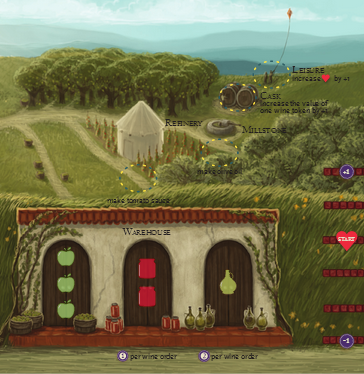 The first is Arboriculture, which was initially a Kickstarter-included expansion in Viticulture. In Tuscany, it’s been updated and is included by default. Arboriculture adds a new mini board to your crush pad, opening up new opportunities to capitalize on selling more products such as olive oil, apples, and tomato sauce.
The first is Arboriculture, which was initially a Kickstarter-included expansion in Viticulture. In Tuscany, it’s been updated and is included by default. Arboriculture adds a new mini board to your crush pad, opening up new opportunities to capitalize on selling more products such as olive oil, apples, and tomato sauce.
In addition to adding new structures and actions to take, players must also now contend with the morale of their workers. If they are overworked, their morale drops, and this can affect your VP. But don’t worry, there are ways of cheering them up. Like giving them time off.
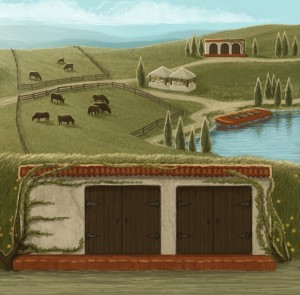
Prototype Shown
The second is Formaggio. Surely having been revealed by now, this Stretch Goal expansion provides players the options to get into the cheese business. Players start off with a single cow (though there’s room for a few more). Milk is then turned into cheese and stored in a cheese cellar that ages just like wine.
However, many cheeses have an expiration date. Formaggio affords players the choice of focusing on short-term cheese rewards or more long term investments for higher yields. This is done by using the influence tokens from the Extended Board expansion. Since the same tokens are used both for Formaggio and regional influence, though, you will have to decide how much cheese is personally worth to you.
Tuscany more than doubles the amount of material to focus on when you’re finally working with Tier III expansions. It also provides a fun story to tell about how your vineyard grew the way it did through choosing how it will unfold. The legacy-style approach to unveiling (or ‘uncorking’) each expansion gives players adequate time to adjust to the nuances each expansion offers without overloading them with too much new information. However, Tuscany doesn’t go so far as to add complete permanence: once all of the expansions are unlocked, you do have the option of simply starting over and trying a different approach.
If one thing is evident in Tuscany, it’s that a good wine can take you to great places. And this trip will not disappoint you. Tuscany gives players new strategic directions and bushels of new gaming opportunities, all while retaining the thematic resonance that made the base game so popular. Tuscany is Viticulture aged just right, and it’s all the better if you savor every bit. If you’d like to learn more about expanding your own vineyard to unfathomable heights, be sure to check out their Kickstarter.
[sc:Preview-Sealer ]

